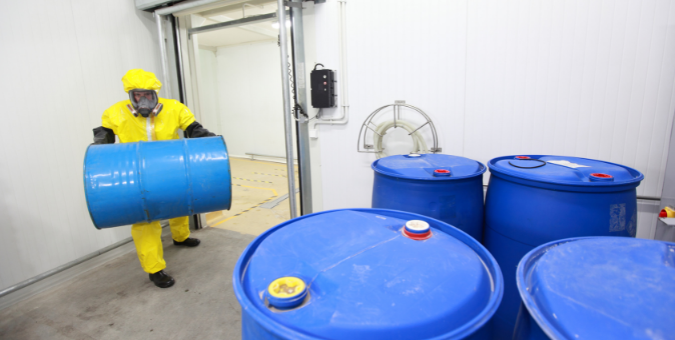
Chemicals of some sort or another are stored, and used, in a multitude of workplaces and businesses. These include the more obvious places such as laboratories and factories, and those that are less so, including hairdressers, offices, or even our own homes.
Every year thousands of workers sustain injury or develop ill health as a result of the substances they work with. Some of the most common conditions are asthma, lung cancer and dermatitis, and injuries sustained include burns and broken bones.
What legal protection is there when working with chemicals?
There are specific laws to protect employees against harm from chemicals that are classified as hazardous substances and are therefore a danger to health. Other substances such as dust from flour, or from cutting wood or stone, can also be classed as hazardous.
The Control of Substances Hazardous to Health Regulations 2002 (COSHH) set out an employer’s legal obligations. The regulations state that an employer must find out what the health hazards are in relation to each chemical or hazardous substance being used. Some chemicals are harmful if inhaled or ingested and some can cause damage if they come in contact with skin. Others can cause a fire or explosion if not stored correctly. Some are very obviously dangerous such as bleach, while others, like water, are less so. While usually harmless to skin, if an employee’s hands are constantly wet over an extended time period, they can develop dermatitis and irritation. An employer must also consider the level of damage the substance could do. Some only cause harm over an extended period of exposure.
The regulations state that once the hazards have been identified, a risk assessment must be done to consider how harm to employees can be prevented or reduced, and control measures introduced. These measures could be requiring employees to wear protective clothing and masks (PPE) or ensuring there is adequate ventilation. The regulations also require employers to put in place monitoring to ensure that the control measures are being followed and they must ensure that staff are adequately trained.
It’s important to note that an employer is not expected to prevent all harm that can arise from the use of chemicals. If you sustain injury from a substance you’ve come into contact with at work, there isn’t an automatic right to compensation. The employer must have been negligent, which in this context, usually means that they didn’t fully comply with the regulations. If they can show that they complied by doing all they reasonably could to reduce the risk of harm, they are unlikely to be found at fault, and in that situation, no compensation would be payable, irrespective of the injury suffered.
The duty on a business to reduce the risk of harm extends to customers or others who may be affected. This means that even if you are self employed with no employees, you still need to consider your obligations under COSHH, although in these circumstances the monitoring and health surveillance obligations won’t apply.
What if an employer has done a risk assessment?
In many cases where injury has occurred, we find that the employer actually has done a risk assessment and identified control measures to reduce the risk of harm. They may even have introduced training for employees on these control measures.
Often however, employers become complacent and fail to adequately implement and monitor the control measures. The control measures need to work every day and be updated if anything changes. For example, a business might fit an extractor to remove dust. However, if over time the extractor becomes less efficient or isn’t cleaned or maintained properly, the safety measure becomes less effective and the risk of harm increases. In this situation, an employee may well have a valid claim for compensation if they become ill as a result of inhaling hazardous dust as the employer has failed in their COSHH obligations. Other common failings are when the PPE provided by an employer is ineffective or in a poor condition, or when rules governing the time an employee can work in a certain environment are not enforced and as a result their exposure increases past safe levels.
Employers also need to train their employees to use any equipment or PPE correctly. For example, if a respirator is provided, the employee needs training to ensure it fits and is used correctly. It isn’t enough to have identified a risk and have a list of control measures, if in practice there isn’t the equipment, monitoring or training needed to ensure the risk is controlled. There is where witness evidence and photographs can be useful to evidence the real-life working environment and practices.
It is crucial to seek advice from a specialist solicitor if you’ve suffered ill health or an injury from a chemical or hazardous substance at work. They can help determine whether your employer breached their COSHH obligations and whether compensation can be claimed.


















